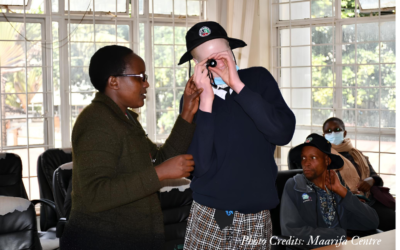Summary
Skin cancer in people with albinism often begins as a small, seemingly harmless spot that gradually worsens, becoming darker, crusty, or painful. If ignored, these subtle changes can lead to the spread of cancerous cells, requiring expensive treatments that are typically out of reach for those with limited means. For people like Frank, living in poverty and constantly exposed to the sun, early detection and prevention are crucial yet largely inaccessible.
Imagine spending every day under the blazing sun, with no shade, sunscreen, or protective clothing. For many people with albinism in coastal regions like Kilifi, this is an everyday reality. The sun, which most people rely on for warmth and energy, becomes a relentless enemy for those whose skin lacks melanin—the natural barrier against harmful UV rays.
Let’s talk about skin cancer and how it silently creeps into the lives of individuals with albinism, especially those struggling to make ends meet. Meet Frank, a 37-year-old man working in the Juakali sector in Kilifi. Frank does odd jobs under the scorching sun to support his family. Despite his hard work, like many others, he never learned the importance of protecting his skin from the sun.
Frank’s story is one of resilience, but also one of unintentional neglect. He wakes up early, grabs his tools, and works all day. But as he toils under the sun, his skin is silently being damaged. Without melanin to protect him, each hour spent under those harsh rays leaves his skin more vulnerable.
It starts innocently enough—a small mole, a rough patch, or a bump that doesn’t seem like a big deal. In Frank’s case, it was a tiny spot on his arm that he ignored. With bills to pay and mouths to feed, who has time to worry about a little spot? But that tiny spot wasn’t harmless. Over time, it grew larger, changed color, and began to itch and bleed. What started as something easy to overlook was actually the early sign of skin cancer.
Skin cancer in people with albinism doesn’t announce itself with fanfare. It’s sneaky, starting almost unnoticeably before growing into a life-threatening issue. Here’s how it typically unfolds:

- The First Clue: A Small Spot
It might be a mole, a rough patch, or a sore that doesn’t heal. For someone like Frank, working outdoors every day, these things are easy to dismiss as just another mark from a tough job.
- The Subtle Changes: Growth and Discomfort
Over time, the spot doesn’t disappear. It starts changing—becoming darker, uneven in shape, or crusty. It might begin to itch, hurt, or bleed. By this point, there’s still often no alarm, but these are signs that the skin cells are turning cancerous.
- The Serious Stage: Spreading
If ignored, those cancer cells can spread beyond the skin. What began as a tiny, unnoticed spot can become a life-threatening condition requiring expensive treatments and surgeries—far beyond the reach of someone like Frank, whose income barely covers basic needs.
The Real Struggles Behind Skin Cancer.
Albinism is characterized by a lack of pigmentation in the skin, hair, and eyes, causing extreme sensitivity to sun exposure. According to a 2015 report by the United Nations, most people with albinism in sub-Saharan Africa die from skin cancer between the ages of 30 and 40. This condition is four to five times more prevalent in the region than in other parts of the world, with occurrences of up to one case per 1,500 people. The lack of information linking albinism and skin cancer only exacerbates the issue, even though these dramatic consequences are largely preventable. Simple measures, like using sunscreen and wearing protective clothing, can make a world of difference.
For individuals with albinism in poverty-stricken communities, skin cancer isn’t just a health issue—it’s tied to much bigger challenges. Education on sun protection, access to affordable sunscreen, and regular skin checks are luxuries, not realities. Without these, many continue to face this silent threat head-on, often unaware of the damage until it’s too late.
Frank’s story is a powerful reminder of the unseen battles fought by people with albinism. It underscores the importance of communities understanding the risks and having the tools to prevent these problems before they escalate. Sun protection might seem basic, but for someone without access or knowledge, it could mean the difference between a healthy life and one overshadowed by the devastating effects of skin cancer.
Protecting What Matters
Here’s what can make a difference:
- Sun Protection: Daily application of sunscreen, wearing wide-brimmed hats, and covering up with long sleeves are essential practices. Even when working under the sun, these small changes can help prevent long-term skin damage.
- Regular Skin Checks: Monitoring any changes in moles, spots, or skin texture is crucial. Early detection of skin cancer is often life-saving.
- Community Awareness: Educating people, especially in sun-intense regions like Kilifi, about the importance of skin care for those with albinism can empower them to protect themselves and seek help when needed.
At the end of the day, stories like Frank’s aren’t isolated—they’re happening quietly, under the radar, all across the country. But with more awareness and better access to resources, we can change that narrative. Skin cancer doesn’t have to be a losing battle. With the right care and knowledge, the sun doesn’t have to be an enemy—it can go back to being a source of warmth and light, just as it should be.



0 Comments